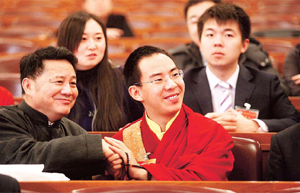Full text: Report on national economic, social development
(Xinhua)
Updated: 2010-03-16 14:14
4. We worked harder to conserve energy, protect the environment and tackle climate change.
New progress was made in energy conservation and emissions reduction. Central government investment and incentive funds were used to support a total of 1,318 major energy conservation projects, capable of generating energy savings equivalent to 75 million tons of standard coal per year. Energy-efficient buildings with total floor area of 960 million square meters were built in 2009, capable of generating energy savings equivalent to 9 million tons of standard coal. We used government subsidies to get people to install over 5 million high-efficiency, fixed-frequency room air-conditioners and 150 million efficient light bulbs. Progress was made in demonstration projects for energy-efficient vehicles and new energy vehicles in 13 cities including Beijing, Shanghai and Chongqing. Central government investment was used to support 132 key projects related to the circular economy and resource conservation. We intensified publicity activities, such as the campaign to get everyone to save energy and reduce emissions. Energy consumption per unit of GDP dropped by 2.2%. Sulfur dioxide emissions and chemical oxygen demand were lowered by 4.6% and 3.3% respectively. Water consumption per 10,000 yuan of value-added of industry decreased by 8.2%, 2.6 percentage points higher than planned. The percentage of industrial solid waste that was comprehensively utilized reached 66.6%, a year-on-year increase of 2.3 percentage points, and 0.7 percentage points higher than planned.
We intensified our ecological improvement and environmental protection efforts. Progress was made in major ecological projects, including those to protect virgin forests, build shelterbelts, return farmland to forests, control the sources of dust storms that affect Beijing and Tianjin, and return grazing land to grasslands. An additional 5.885 million hectares of land were planted with trees, raising the percentage of China's land area covered by forests to 20.36%. We constantly intensified our efforts to control soil erosion in key areas. A comprehensive project to prevent karst regions from becoming stony deserts was launched. Smooth progress was made in treating industrial wastewater and waste gases and in preventing and controlling water pollution in key water basins, including the Huai, Hai and Liao rivers and the Tai, Chao and Dianchi lakes. The daily urban sewage treatment capacity rose by 13.3 million cubic meters, and the daily capacity of urban garbage disposal rose by 50,000 tons. The percentage of urban sewage treated reached 72.3% and the percentage of safely handled urban household waste reached 69%, up 2.1 and 2.2 percentage points over the previous year respectively, and 3.3 and 2 percentage points higher than planned. The system of indices for assessing compliance with clean production standards in 11 industries was released. Desulphurization devices were installed in thermal power generating units with a total capacity of 102 million kilowatts, raising the percentage of the total capacity of thermal power generating units so equipped to 72%.
We made new progress in addressing climate change. We conscientiously implemented China's National Climate Change Program. We energetically carried out Clean Development Mechanism projects. We actively promoted R&D on and application of climate-friendly technologies. We set action targets for limits on China's greenhouse gas emissions by 2020. We played a constructive role in international talks and making international rules for dealing with climate change, actively engaged in international exchanges and joint programs, strengthened cooperation and dialogue with relevant countries, and upheld China's legitimate rights and interests in development.


